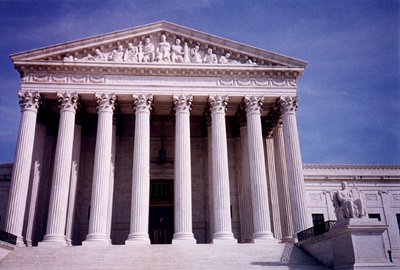All Nonfiction
- Bullying
- Books
- Academic
- Author Interviews
- Celebrity interviews
- College Articles
- College Essays
- Educator of the Year
- Heroes
- Interviews
- Memoir
- Personal Experience
- Sports
- Travel & Culture
All Opinions
- Bullying
- Current Events / Politics
- Discrimination
- Drugs / Alcohol / Smoking
- Entertainment / Celebrities
- Environment
- Love / Relationships
- Movies / Music / TV
- Pop Culture / Trends
- School / College
- Social Issues / Civics
- Spirituality / Religion
- Sports / Hobbies
All Hot Topics
- Bullying
- Community Service
- Environment
- Health
- Letters to the Editor
- Pride & Prejudice
- What Matters
- Back
Summer Guide
- Program Links
- Program Reviews
- Back
College Guide
- College Links
- College Reviews
- College Essays
- College Articles
- Back
Marshall Court and Federalism
When the federal system was first established, the relationship between the national and the state governments was not clear. Then, a series of Supreme Court cases headed by Chief Justice John Marshall contributed to the modification of the system and further cleared the relationship between national and state governments.
An early Supreme Court case that helped define the national power is McCulloch v. Maryland (1819). After the Second Bank of United States was chartered by the Congress, the Maryland state legislature levied taxes from all the banks including the national bank. James McCulloch, representing the national government in the Baltimore branch, refused to pay the tax and was therefore suited by the Maryland state government. This lawsuit was eventually brought up to the Supreme Court. Faced with the question that whether the Congress had the right to charter a national bank, John Marshall explained with several enumerated powers given to the Congress, such as, to levy and collect taxes and issue currency. Accordingly, Marshall revealed the reasonability of the Congress’s power to establish a national bank, because it was “necessary and proper” for the government to operate, as stated in Article I Section 8 in the Constitution. He follows his first statement by mentioning the supremacy clause in the Constitution. Therefore, the national government is supreme to the state government, and the state governments have no right to levy the national bank. This Supreme Court case clearly defined the power of the national government, specifically the constitutional power given to the federal government to charter a national bank, and emphasized on the supremacy of it over the state governments.
Another Supreme Court case is Gibbons v. Ogden (1824), which defined the national government’s role in interstate commerce. When Ogden was granted to operate steamboats on the Hudson River, the Congress meanwhile gave a license to Gibbons to operate between states. New York and New Jersey soon demonstrated their interest in regulating the commerce in the region, but Gibbons raised a question on the scope of national government’s power under the commerce clause. He pointed out that, the clause entitled the Congress not only to regulate the consumption of goods but also the commerce activities between states. Therefore, the Supreme Court decided that New York did not have the authority to take charge of the Hudson River, but the Congress did.
Gibbons challenged Ogden, leading to another series of thinking on the relationship between the federal and state governments. This case establishes the federal government’s dominant role in interstate commerce, again proving that Federal government is supreme over states.
Barron v. Baltimore (1833) limited the Bill of rights. John Brown was a businessman who had a successful docking business in Baltimore. However, when the city started massive construction, the dirt, sand, and silt from the construction sites were brought to the part of the wharf that was owned by Barron, making him unable to run his business. Therefore, based on the 5th amendment which states that takings by the government should be compensated, Barron decided to sue the state government, raising the question whether the Bill of Rights applied to the state governments. The Supreme Court eventually declared that the scope of Bill of Rights restricted to the national government, so Barron did not have an argument supporting him to ask for compensation from the state government. This Supreme Court case has successfully defined the effectiveness of the Bill of Rights, further clarifying the relationship between the national and state governments.
McCulloch v. Maryland (1819), Gibbons v. Ogden (1824), and Barron v. Baltimore (1833) are three major Supreme Court cases that help establish and clarify the federal system. The national and state government can, therefore, create a clear and reliable relationship.

Similar Articles
JOIN THE DISCUSSION
This article has 0 comments.
